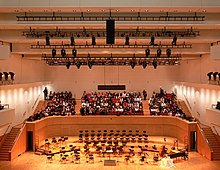Salle Pleyel
The Salle Pleyel was up to the opening of the Philharmonie de Paris in 2015 the only major symphonic concert hall in the city of Paris . It is named after the Austrian composer and piano manufacturer Ignaz Josef Pleyel . The building, located at 252 Rue du Faubourg Saint-Honoré in the 8th arrondissement of Paris , was built in 1927 according to plans by the architect Gustave Lyon in the Art Deco style .
History and meaning
In 1839 the piano manufacturer Pleyel , led by Camille Pleyel , moved from 9 rue Cadet, Paris to the building complex 20–24 rue Rochechouart, which was completed in December. It included workshops, exhibition rooms and concert halls. The concert hall at 22 rue Rochechouart and inaugurated on December 25, 1839, the actual 1st Salle Pleyel, was located inside the building complex. The 30 meter long and 7 meter wide hall had 550 seats. A 'grand salon de côté' ("large side salon") with 150 seats and a 'petit salon de côté' ("small side salon") were part of the ensemble. Before that, at 9 rue Cadet, concerts were held in the “salons de MM Pleyel”, smaller rooms that also served as showrooms. They held about 100 people. After the construction of the new hall in 1927 in rue du Faubourg Saint-Honoré, the old hall in 22 rue Rochechouart was demolished in 1929.
Since its opening in 1839, the first Salle Pleyel has hosted the greatest musicians of its time, such as B. Chopin and Clara Wieck . In 1846, at the age of eleven , Camille Saint-Saëns gave his first public concert in the Salle Pleyel. Other famous debutants were César Franck , Artur Rubinstein and Jeanne Demessieux . In February 1923 Gabriel Fauré's Trio for piano, violin and violoncello in D minor op. 120 was premiered by Alfred Cortot , Jacques Thibaud and Pablo Casals . The Salle Pleyel has seen numerous other world premieres in the course of its history, such as the Concerto in G major by Maurice Ravel (1932).
The artists of the 20th century who made guest appearances here include: a. Teresa Berganza , Anja Silja and Dietrich Fischer-Dieskau , the organist Rolande Falcinelli , the conductor Eugen Jochum , Nikolaus Harnoncourt with the Concentus Musicus Vienna , Karl Richter and the Munich Bach Choir , the pianists Krystian Zimerman and Brigitte Engerer and the violinist Hilary Hahn .
There are also a number of famous live recordings by jazz musicians such as Dizzy Gillespie (1948), the Festival International 1949 de Jazz with Sidney Bechet , Charlie Parker and the Miles Davis / Tadd Dameron quintet, as well as Gerry Mulligan (1954) ( Pleyel Concert 1954 ) , Julian Cannonball Adderley ("Salle Pleyel," 1960), Count Basie ("Concert - Salle Pleyel," 1972), Oscar Peterson ("Live At The Salle Pleyel," 1997) and Keith Jarrett ("Over the Rainbow and C The Blues ", 1992). On January 31, 1952, the second recording of the world-famous Petite fleur , composed by Sidney Bechet , was recorded here with Claude Luter's orchestra .
The Salle Pleyel also became famous through an initiative of socialist and pacifist forces. At the so-called Pleyel Congress in the famous concert hall in 1933 the Anti-Fascist Workers' Congress adopted a “Manifesto against Fascism and Imperialist War”. Because an anti-war congress had been held in Amsterdam a year earlier , there was later talk of an Amsterdam-Pleyel movement against the war.
The new Salle Pleyel
The Salle Pleyel was renovated between 2002 and 2006 under the direction of the architect Francois Ceria and according to calculations by the acousticians Russel Johnson and Tateo Nakajima of the New York office Artec Consultants for a total of 33 million euros for the account of the entrepreneur Hubert Martigny, a co-founder of the consulting group ALTRAN and modernized. The number of seats was reduced from 2370 to 1913, the room volume increased by 20 percent and the acoustic quality improved at the same time. For years there had been a bitter dispute over the construction work, which had been triggered by the former director of the Salle Pleyel Carla Maria Tarditi .
The new Salle Pleyel was opened in September 2006 with a performance of Gustav Mahler's “ Resurrection Symphony ” by the Orchester de Paris under the direction of its chief conductor Christoph Eschenbach .
The concert hall is operated by a branch of the public Cité de la musique . She leased the Martigny complex for fifty years and will then be able to buy it for one euro.
literature
- Peter Hagmann: Appearance new, problems unsolved . In: Neue Zürcher Zeitung , No. 142, June 22, 2007 ( online edition )
- Arnaud Marion: Pleyel. Une histoire tournée vers l'avenir . Éditions de la Martinière, Paris 2005.
Individual evidence
- ↑ http://www.rosa-luxemburg-bildungswerk.de/Veranstaltungen/France_Bloch-Serazin/france_bloch-serazin.html
- ↑ http://david.juden.at/kulturzeitschrift/70-75/75-soxberger.htm
Web links
Coordinates: 48 ° 52 ′ 37.2 " N , 2 ° 18 ′ 3.7" E


